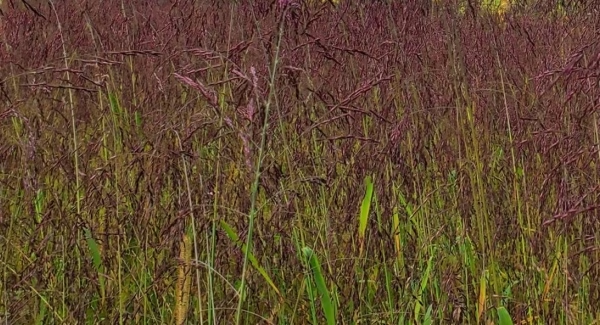
Purpletop
Botanical Name
:
Tridens flavus
Plant Type
:
Ornamental grass, perennial warm-season grass
Seasons
:
Grows in spring and summer, flowers in late summer to fall
Sun Level
:
Full sun to partial shade (6+ hours of sunlight)
Ideal Soil Temperature for Planting
:
65-75°F (18-24°C). Best planted in late spring or early summer
Soil Type
:
Well-drained, loamy, or sandy soil and can tolerate poor soils
Germination
:
14-21 days, optimal at 70°F (21°C)
P.H. Level
:
5.5-7.5 (acidic to neutral)
Water/Irrigation
:
Drought-tolerant once established; occasional deep watering in dry periods
Fertilization
:
Not needed. Apply a light organic fertilizer in early spring if the soil is poor
Habit
:
Upright, clumping with arching stems
Propagation
:
Seed is the most common method. Division is possible, but not typically practiced
Final Plant Height
:
3-5 feet (90-150 cm)
Spread
:
2-3 feet (60-90 cm)
Spacing
:
18-24 inches apart for best growth
Flowers
:
Reddish-purple, airy seed heads appearing in late summer, turning golden brown in fall
Attracts
:
Birds (seeds in fall), pollinators
Uses
:
Naturalistic landscapes, erosion control, meadows, borders
Companions
:
Black-eyed Susans, Coneflowers, Switchgrass, Little Bluestem
Pruning
:
Cut back in early spring before new growth emerges
Toxicity
:
Non-toxic to humans and pets
Pests
:
Generally pest-free but may attract occasional aphids
Diseases
:
Resistant to most diseases but can develop rust in overly humid conditions
Fun Fact
:
The name “Purpletop” comes from its stunning purplish seed heads that shimmer in the sunlight, making it a standout feature in prairies and meadows
Botanical Name
:
Tridens flavus
Plant Type
:
Ornamental grass, perennial warm-season grass
Seasons
:
Grows in spring and summer, flowers in late summer to fall
Sun Level
:
Full sun to partial shade (6+ hours of sunlight)
Ideal Soil Temperature for Planting
:
65-75°F (18-24°C). Best planted in late spring or early summer
Soil Type
:
Well-drained, loamy, or sandy soil and can tolerate poor soils
Germination
:
14-21 days, optimal at 70°F (21°C)
P.H. Level
:
5.5-7.5 (acidic to neutral)
Water/Irrigation
:
Drought-tolerant once established; occasional deep watering in dry periods
Fertilization
:
Not needed. Apply a light organic fertilizer in early spring if the soil is poor
Habit
:
Upright, clumping with arching stems
Propagation
:
Seed is the most common method. Division is possible, but not typically practiced
Final Plant Height
:
3-5 feet (90-150 cm)
Spread
:
2-3 feet (60-90 cm)
Spacing
:
18-24 inches apart for best growth
Flowers
:
Reddish-purple, airy seed heads appearing in late summer, turning golden brown in fall
Attracts
:
Birds (seeds in fall), pollinators
Uses
:
Naturalistic landscapes, erosion control, meadows, borders
Companions
:
Black-eyed Susans, Coneflowers, Switchgrass, Little Bluestem
Pruning
:
Cut back in early spring before new growth emerges
Toxicity
:
Non-toxic to humans and pets
Pests
:
Generally pest-free but may attract occasional aphids
Diseases
:
Resistant to most diseases but can develop rust in overly humid conditions
Fun Fact
:
The name “Purpletop” comes from its stunning purplish seed heads that shimmer in the sunlight, making it a standout feature in prairies and meadows
Written by Salome Wapukha – https://www.linkedin.com/in/salome-wapukha-556700193/

